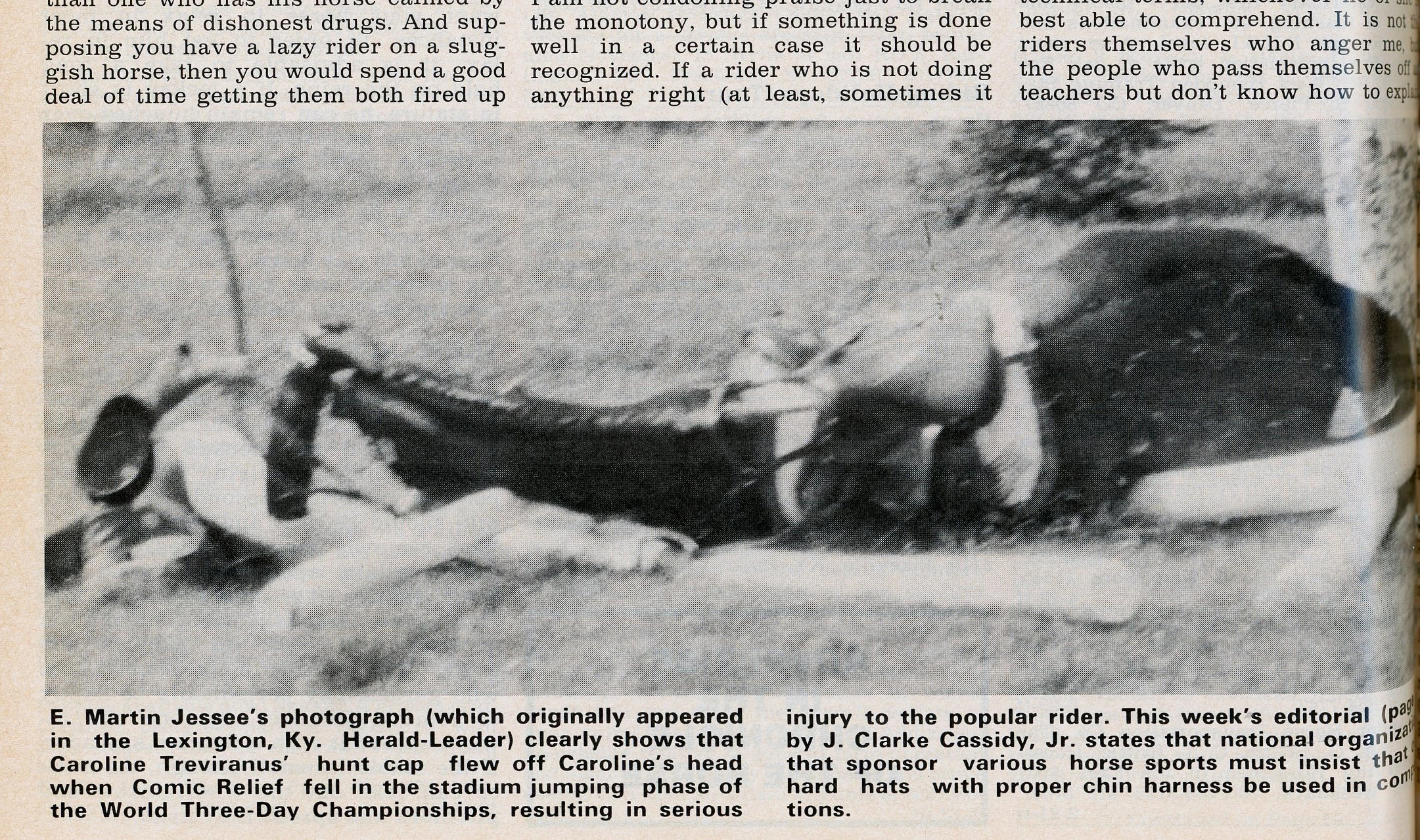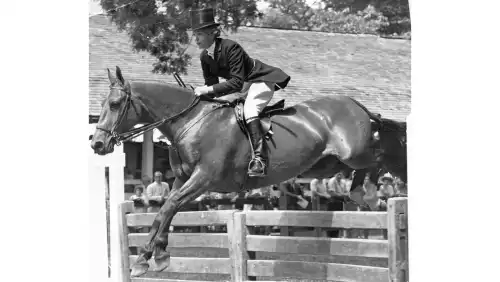In the Feb. 26 and March 12 issues of The Chronicle of the Horse we published a two-part series about concussion research and the role of helmets in protecting equestrians’ heads. The transition from sport horse riders wearing hunt caps and items of apparel to protective helmets was spurred on by tragic circumstances, when Caroline Treviranus suffered a serious head injury during the show jumping portion of the 1978 World Eventing Championships (Kentucky). Her hunt cap fell off her head before she hit the ground, and she spent weeks in the hospital recovering. Thanks to the impact of the event, the Chronicle made the difficult editorial choice to re-publish a photo of the fall.
Clarke Cassidy Jr., a member of the advisory committee for the U.S. Pony Clubs, wrote this guest editorial, which ran in our Oct. 15, 1978, issue, inflaming passions among those who valued their traditional head gear and those ready to commit to safety helmets. The letter is credited with helping to galvanize safety advocates within the USPC and eventing communities, and shortly after USPC started safety helmet prototypes that eventually developed into the first ASTM approved helmet.
One Picture Equals A Thousand Words
A graphic picture by E. Martin Jessee of the Lexington Herald-Leader appears on page 60 of this issue. No, this photograph isn’t pleasant, but it’s worth a thousand words, and it underscores the seriousness of the continuing procrastination by horse organizations in the matter of mandatory safety head gear.
The picture shows that Caroline Treviranus and her “hunt cap” are clearly parting company during the stadium jumping phase of the World Three-Day Championships. Not to belabor the point, but had Caroline been wearing a properly engineered cap, fitted with a full chin harness (exactly like the one she wore on the cross-country phase), Caroline’s head injury might have been prevented or, at least, minimized.
ADVERTISEMENT
Still, fashion-conscious riders, including the foxhunting fraternity and all of Caroline’s fellow competitors in the stadium phase at Lexington, resist any change in the traditional appearance of the cap. In addition, many coaches permit their “macho” pupils to train over fences with no headgear at all. I personally observed this one morning in a schooling session over fences at the Kentucky Horse Park. Children, too, were present, and I concluded that some of these children must have thought as follows: “My heroes don’t wear hard hats, why should I?” Also, I might add that the American Horse Shows Association and the United States Combined Training Association have paid little attention to this aspect of accident prevention for their approved jumping competitions, while concurrently mandating ambulance and physician coverage of these affairs to pick up the pieces.
The United States Pony Clubs Inc., while requiring hunt caps with at least an elastic chin strap, and recommending a full harness, hesitates to publicly recommend by brand name the few caps which actually provide reasonable protection , since none has yet received Snell Foundation approval. (The Snell foundation is dedicated to safety in sports and, reportedly, one make of hard hat does currently meet Snell requirements until exposed to extreme heat.)
Jockeys, downhill ski racers, race car drivers, motorcycle racers, football players and hockey players, among others, must wear approved head gear during competition. On September 17, however, 70,000 spectators witnessed one result of the failure of the horse community to act in this regard. The news of our negligence has been reported world-wide, with the following words appearing in a recent issue of The Irish Field: “The young American girl who was injured in Kentucky was wearing a hat, but because it was not properly secured it naturally fell to the ground when she was thrown. I’m afraid that it’s not sufficient to just plunk a hat on your head; it’s got to be a good quality one with a strap.”
In conclusion, an inter-organizational panel representing the sports medicine profession, the Snell Foundation, cap manufacturers, as well as the national organizations regulating horse showing and eventing should be convened forthwith, with a mandate to cut through the thicket of custom and prejudice which to date has discouraged manufacturers from developing caps that incorporate the minor changes of shape which are apparently required to achieve Snell Foundation approval. The proposed Panel must establish a timetable for the eventual required use of such caps in all types of competition. I further suggest that the American Horse Council, which has gained a nationwide respect for getting things done, provide the leadership to make this conference a reality.
Finally, I wish Caroline (who is a graduate A Pony Clubber, incidentally) a speedy recovery, and I apologize, Caroline, for having made you an example, so to speak. However your name is known in horse circles the world over, and I feel that you would want some good to result from your adversity. Hopefully your experience will even prevent future accidents—and yes, even save lives.
If you haven’t seen The Chronicle of the Horse magazine lately, you’re missing out. Check out the Feb. 26 and March 12 issues of the Chronicle, which feature plenty of thoughtful features and analysis on issues across the sport horse world in addition to the timely stories about head injuries. What are you missing if you don’t subscribe?















